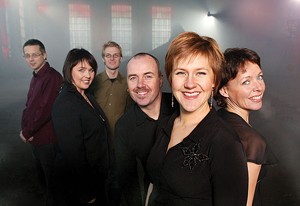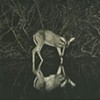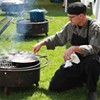Published February 13, 2008 at 9:35 a.m.
Sixteenth-century religious reformer Martin Luther probably never made the famous quip often attributed to him — “Why should the devil have all the good tunes?” — in which “the devil” meant the Catholic Church. But he did issue a call to arms for fresh Protestant music, and composed many rousing hymns himself. The tone of the spurious quote captures the fierce competitiveness of Europe’s musical scene at the time. War raged between Catholics and Protestants militarily, philosophically and artistically.
As kings fought over territory, they also tried to snag the best composers for their courts and personal chapels. Spain’s Carlos V conquered a large part of the continent during his reign (1519-56) and cultivated an impressive musical stable. Nordic Voices, a six-member vocal ensemble from Norway, treated a rapt Burlington audience to an evening of a cappella motets drawn primarily from this Spanish Golden Age.
In introducing the group, baritone Frank Havrøy cheekily highlighted the historical context: “Out of the height of the Spanish Inquisition came this wonderful music. Have a nice evening!” He got a great laugh from the crowd, but his point was provocative. The same ruler who commissioned ethereal settings of sacred texts also ordered up waterboarding and thumbscrews for “heretics.” Hmm, maybe that’s how he got all the good tunes.
Nordic Voices sang them brilliantly and flawlessly. Six-part harmony, with just one singer per part and without instrumental accompaniment, leaves no room for error. These polished pros, graduates of Norway’s top musical academies, have been together since 1996; the three men and three women performed with a sense of joy that made their excellence seem effortless.
Friday’s program, entitled “Reges Terrae” (The Kings of the Earth), consisted of seven religious motets from King Carlos’ era and three modern ones, also set to sacred Latin texts. The singers stood in a gentle arc on the hall’s acoustically friendly wood stage, with music stands low and flat in front of them. For the Renaissance pieces, the genders remained mixed, but they reshuffled with men on one side and women on the other for the contemporary works. The physical arrangement differed because blend and harmony were paramount in the old pieces; contrast and drama in the new.
Two of the king’s composers had multiple pieces featured: Flemish Pierre de Manchicourt (1510-64) and Spaniard Cristobal Morales (1512-53). Morales’ “Regina caeli” (Queen of the heaven) exemplified how Nordic Voices approached the Renaissance motets: rendering ethereal harmonies sweetly while maintaining crisp, dancelike rhythms. It opened with a gentle tennis match of counterpoint developing beneath the soprano’s melody line, which unfolded in longer notes above the other parts.
At Carlos’ court, of course, boys would have sung the upper-register parts. The women of Nordic Voices — two sopranos and one mezzo-soprano — demonstrated the superior tonal depth and richness that female voices bring to parts originally composed for boys. Many period performances would also have taken place in stone buildings such as cathedrals and chapels, where vocal overtones resonate differently — more echo and mystery — than they do in a modern concert space. The Recital Hall’s advantage? It yielded every note with clarity and refinement.
While the first half of the program emphasized celebratory themes — praise, hail, exalt, rejoice — the second featured more reflective texts. Three different settings of “O Magnum Mysterium” (O Great Mystery), a meditation on Christ’s birth in a stable, provided period contrasts.
French composer Francis Poulenc (1899-1963) penned the best-known choral setting of this quirky Christmas text. Nordic Voices accentuated the lyricism of his 20th-century interpretation, with its softly descending melodic line and elegant use of dissonance. More ambitious to sing, and to hear, was Henrik Ødegaard’s 2006 rendering, part of a project to “teach classical singers to sing something else,” according to baritone Havrøy.
It was adventurous and definitely crowd-pleasing. Inspired by cultural practices as varied as those of Tibetan monks and the Inuit, Ødegaard integrated techniques such as throat singing and quartertones into the motet form. As the piece went on, however, it felt like too many ingredients kept getting chucked into a musical stew.
I preferred the devilishly good Catholic tunes.
More By This Author
Speaking of...
-

Records Show UVM Professors Questioned Decision to Nix Palestinian Writer’s Appearance
Dec 20, 2023 -

UVM Strikes Deal With Burlington That Could House More Students on Campus
Dec 18, 2023 -

Two Local Band Directors March in the Macy's Parade
Nov 22, 2023 -

Before a Burlington Show, the Wood Brothers Get Back to Basics
Oct 26, 2023 -

Burlington Area Selected as Semiconductor 'Tech Hub'
Oct 25, 2023 - More »
Comments
Comments are closed.
From 2014-2020, Seven Days allowed readers to comment on all stories posted on our website. While we've appreciated the suggestions and insights, right now Seven Days is prioritizing our core mission — producing high-quality, responsible local journalism — over moderating online debates between readers.
To criticize, correct or praise our reporting, please send us a letter to the editor or send us a tip. We’ll check it out and report the results.
Online comments may return when we have better tech tools for managing them. Thanks for reading.














































